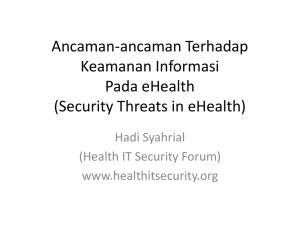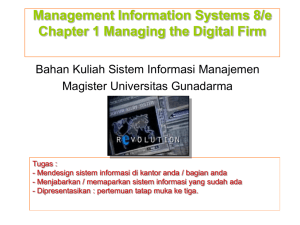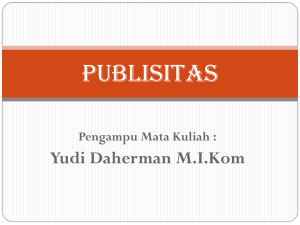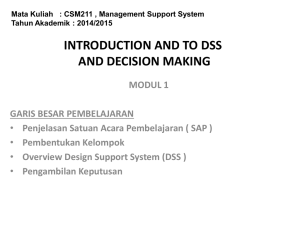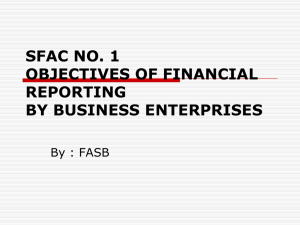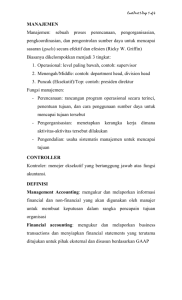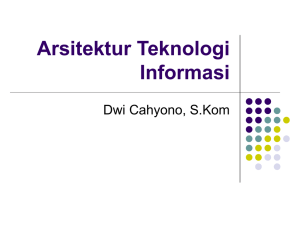Keamanan Informasi
advertisement
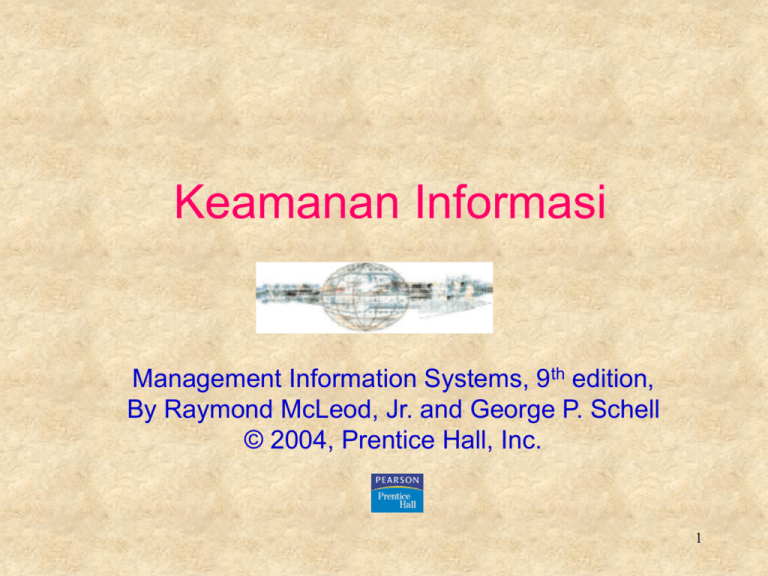
Keamanan Informasi Management Information Systems, 9th edition, By Raymond McLeod, Jr. and George P. Schell © 2004, Prentice Hall, Inc. 1 Pengantar • • Keamanan informasi dimaksudkan untuk mencapai kerahasiaan, ketersediaan, dan integritas di dalam sumber daya informasi perusahaan. Manajemen keamanan informasi terdiri dari: 1. Perlindungan Sehari-hari disebut Manajemen Keamanan Informasi (information security management/ ISM) 2. Persiapan untuk menghadapi operasi setelah bencana disebut Manajemen Kesinambungan Bisnis (business continuity management /BCM) 2 Kemanan Informasi • Kemanan Informasi menggambarkan usaha untuk melindungi komputer dan nonperalatan komputer, fasilitas, data, dan informasi dari penyalahgunaan oleh orang yang tidak bertanggung jawab • Definisi ini meliputi pengutip, fax mesin, dan semua jenis media, termasuk dokumen kertas 3 Tujuan Keamanan Informasi • Keamanan informasi dimaksudkan untuk mencapai tiga sasaran utama, yaitu: – Kerahasiaan: melindungi data dan informasi perusahaan dari penyingkapan orang –orang yang tidak berhak – Ketersediaan: meyakinkan bahwa data dan informasi perusahaan hanya dapat digunakan oleh orang yang berhak menggunakannya. – Integritas: sistem informasi perlu menyediakan representasi yang akurat dari sistem fisik yang direpresentasikan 4 Manajemen Keamanan Informasi • Istilah corporate information systems security officer (CISSO) telah digunakan untuk orang yang berada di organisasi yang bertanggung jawab pada sistem keamanan informasi perusahaan. • Saat ini ada istilah baru yaitu corporate information assurance officer (CIAO) yang melaporkan kepada CEO dan mengatur suatu unit jaminan informasi 5 Manajemen Keamanan Informasi (ISM) • • • ISM terdiri dari empat langkah: 1. Identifikasi threats (ancaman) yang dapat menyerang sumber daya informasi perusahaan 2. Mendefinisikan resiko dari ancaman yang dapat memaksakan 3. Penetapan kebijakan keamanan informasi 4. Menerapkan controls yang tertuju pada resiko Gambar 9.1 mengilustrasikan pendekatan manajemen resiko Benchmarks juga digunakan untuk memastikan integritas dari sistem manajemen resiko 6 7 Ancaman • Ancaman keamanan informasi adalah seseorang, organisasi, mekanisme, atau peristiwa yang dapat berpotensi menimbulkan kejahatan pada sumber daya informasi perusahaan • Ancaman dapat berupa internal atau external, disengaja atau tidak disengaja • Gambar 9.2 memperlihatkan tujuan keamanan informasi dan bagaimana keamanan informas diberlakukan terhadap empat jenis resiko: • Ancaman Internal dan External • Disengaja dan tidak disengaja 8 9 Resiko Tindakan tidak sah yang menyebabkan resiko dapat digolongkan ke dalam empat jenis : 1. Pencurian dan Penyingkapan tidak sah 2. Penggunaan Tidak Sah 3. Pembinasaan dan Pengingkaran Layanan yang tidak sah 4. Modifikasi yang tidak sah 10 Ancaman Yang Paling Terkenal – “VIRUS” • sebuah virus adalah sebuah program komputer yang dapat mereplikasi dirinya sendiri tanpa pengetahuan pengguna • sebuah worm tidak dapat mereplikasi dirinya sendiri tanpa sebuah sistem tapi dapat memancarkan salinan dengan sendirinya oleh e-mail • sebuah Trojan horse tidak dapat mereplikasi maupun mendstribusikan dirinya sendiri. Distribusi terpenuhi oleh para pemakai yang mendistribusikannya sebagai utilitas, maka ketika digunakan menghasilkan sesuatu perubahan yang tidak dikehendaki dalam kemampuan sistem 11 Pertimbangan E-COMMERCE • E-commerce telah memperkenalkan sebuah keamanan resiko yang baru: penipuan kartu kredit. Keduanya American Express dan Visa telah mengimplementasikan program yang mengarahkan secara rinci pada e-commerce • American Express mengumumkan “penyediaan" angka-angka kartu kredit. Angka ini, dibandingkan dengan angka kartu kredit pelanggannya, yang ditujukan pada perdagangan eceran menggunakan ecommerce, yang memilih American Express untuk pembayarannya. • Visa telah mengumumkan sepuluh praktek terkait dengan keamanan yang mereka harap pengecernya untuk mengikuti lebih dari tiga langkah praktek yang umum dilakukan 12 Tindakan Pencegahan Visa Pengecer Harus: – Instalasi dan pelihara firewall – Menjaga sistem keamanan selalu “up to date” – Enkripsi penyimpanan data dan sebarkan data – Gunakan dan perbaharui software antivirus – Membatasi akses data bagi mereka yang memang perlu mengetahui – Menugaskan ID unik untuk orang yang memiliki akses data khusus – Menelusuri akses data dengan ID unik – Tidak menggunakan password default dari vendor – Secara teratur menguji keamanan sistem Pengecer perlu: – Memantau pegawai yang memiliki akses data – Tidak meninggalkan data (disket, kertas, dll) atau komputer dalam keadaan tidak aman – Hapus data jika sudah tidak digunakan 13 Manajemen Resiko • The four sub steps to defining information risks are: 1. Identify business assets to be protected from risks 2. Recognize the risks 3. Determine the level of impact on the firm should the risks materialize 4. Analyze the vulnerabilities of the firm • A systematic approach can be taken to sub steps 3 and 4 by determining the impact and analyzing the vulnerabilities • Table 9.1 illustrates the options. 14 15 Risk Analysis Report • 1. 2. 3. 4. 5. 6. 7. 8. The findings of the risk analysis should be documented in a report that contains detailed information such as the following for each risk: A description of the risk Source of the risk Severity of the risk Controls that are being applied to the risk The owner(s) of the risk Recommended action to address the risk Recommended time frame for addressing the risk What was done to mitigate the risk 16 INFORMATION SECURITY POLICY • A security policy can be implemented using the following five phase approach (Fig. 9.3): • Phase 1: Project Initiation • Phase 2: Policy Development • Phase 3: Consultation and Approval • Phase 4:Awareness and Education • Phase 5: Policy Dissemination 17 18 Separate policies are developed for: • • • • • • • • Information systems security System access control Personnel security Physical and environmental security Telecommunications security Information classification Business continuity planning Management accountability These policies are distributed to employees, preferably in writing and in educational and training programs. With the policies established, controls can be implemented 19 CONTROLS • A control is a mechanism implemented to protect the firm from risks or minimize the impact of those risks on the firm should they occur: 1. Technical controls are those built into systems by system developers during the system development life cycle 2. Access control is the basis for security against threats by unauthorized persons 3. Intrusion detection systems try to recognize an attempt to breach security before it has the opportunity to inflict damage 20 21 Access Control 1. User identification. Users first identify themselves by providing something that they know, such as a password 2. User authentication. Once initial identification has been accomplished, users verify their right to access by providing something that they have, such as a smart card or token, or an identification chip 3. User authorization. With the identification and authentication checks passed, a person can then be authorized certain levels or degrees of use. For example, one user might be authorized only to read from a file, whereas another might be authorized to make changes 22 Firewalls • A firewall acts as a filter and barrier restricting the data flowing between the firm’s network and the Internet • There are three types of firewalls: – Packet-Filters – are routers equipped with data tables of IP addresses which reflect the filtering policy positioned between the Internet and the internal network, it can serve as a firewall – Circuit-Level Firewall – installed between the Internet and the firm's network but closer to the communications medium – Application-Level Firewall – located between the router and the computer performing the application 23 Cryptographic Controls • Cryptography is the use of coding by means of mathematical processes • The data and information can be encrypted as it resides in storage and or transmitted over networks • If an unauthorized person gains access, the encryption makes the data and information unreadable and prevents its unauthorized use • Special protocols such as SET (Secure Electronic Transactions) have been developed for use in ecommerce 24 FORMAL CONTROLS • Formal controls include the establishment of: • Codes of conduct • Documentation of expected procedures and practices • Monitoring and preventing behavior that varies from the established guidelines • The controls are formal in that management: • Devotes considerable time to devising them • They are documented in writing • They are expected to be in force for the long term 25 INFORMAL CONTROLS Informal controls include such activities as: • Instilling the firm's ethical beliefs in its employees; • Ensuring an understanding of the firm's mission and objectives; • Education and training programs; and • Management development programs These controls are intended to ensure that the firm's employees both understand and support the security program 26 ACHIEVING THE PROPER LEVEL OF CONTROLS • As all three types of controls, technical, formal, and informal - cost money • The idea is to establish controls at the proper level • The control decision boils down to cost versus return, but in some industries there are other considerations • In banking, when engaging in risk management for ATMs, controls must keep the system secure but not at the cost of diminishing customer convenience • In health care, the system should not be so secure as to reduce the amount of necessary patient information available to hospitals and physicians 27 GOVERNMENT AND INDUSTRY ASSISTANCE • Several governments and international organizations have established standards (next slide) intended to serve as guidelines for organizations seeking to achieve information security • Some are in the form of benchmarks, sometimes referred to as a baseline 28 Government and Industry Assistance • • • • • • United Kingdom's BS7799 The UK standards establish a set of baseline controls. Both Australia and New Zealand have instituted controls based on BS 7799 BSI IT Baseline Protection Manual The baseline approach is also followed by the German Bundesamt fur Sicherheit in der Informationstechnik (BSI). The baselines are intended to provide reasonable security when normal protection requirements are intended. The baselines can also serve as the basis for higher degrees of protection when those are desired COBIT COBIT, from the Information Systems Audit and Control Association & Foundation (ISACAF), focuses on the process that a firm can follow in developing standards, paying special attention to the writing and maintaining of the document GASSP Generally Accepted System Security Principles (GASSP) is a product of the U. S. National Research Council. Emphasis is on the rationale for establishing a security policy GMITS The Guidelines for the Management of IT Security (GMITS) is a product of the International Standards Organization (ISO) Joint Technical Committee and it provides a list of the information security policy topics that should be included in an organization's standards ISF Standard of Good Practice The Information Security Forum Standard of Good Practice takes a baseline approach, devoting considerable attention to the user behavior that is expected if the program is to be successful 29 GOVERNMENT LEGISLATION • Governments in both the U.S. and U.K. have established standards and passed legislation aimed at addressing the increasing importance of information security: – U.S. Government Computer Security Standards – The U.K. Anti-terrorism, Crime and Security Act (ATCSA) 2001 – U.S. Government Internet Crime Legislation 30 INDUSTRY STANDARDS • The Center for Internet Security (CIS) is a non profit organization dedicated to assisting computer users to make their systems more secure • CIS Benchmarks have been established and are integrated in a software package that calculates a "security" score on a 10-point scale 31 PROFESSIONAL CERTIFICATION • Beginning in the 1960s the IT profession began offering certification programs: – Information Systems Audit and Control Association (ISACA) – International Information System Security Certification Consortium (ISC) – SANS (SysAdmin, Audit, Network, Security) Institute 32 PUTTING INFORMATION SECURITY MANAGEMENT IN PERSPECTIVE • Firms should put in place an information security management policy before putting controls in place • The policy can be based on an identification of threats and risks or on guidelines provided by governments and industry associations • Firms implement a combination of technical, formal, and informal controls expected to offer the desired level of security within cost parameters and in accordance with other considerations that enable the firm and its systems to function effectively 33 BUSINESS CONTINUITY MANAGEMENT (BCM) • The key element in BCM is a contingency plan, formally detailing the actions to be taken in the event that there is a disruption, or threat of disruption, in any part of the firm’s computing operation • Rather using a single, large contingency plan, a firm’s best approach is to develop several subplans that address specific contingencies. Such as: • An emergency plan • A backup plan • A vital records plan 34 PUTTING BUSINESS CONTINUITY MANAGEMENT IN PERSPECTIVE • Much effort has gone into contingency planning and much information and assistance is available • Some firms use packaged plans they can adapt to their needs • TAMP Computer Systems markets a Disaster Recovery System (DRS) that includes a database management system, instructions and tools that can be used in preparing a recovery plan • There are also guidelines and outlines that firms can use as starting points or benchmarks to achieve 35 END OF CHAPTER 9 36
